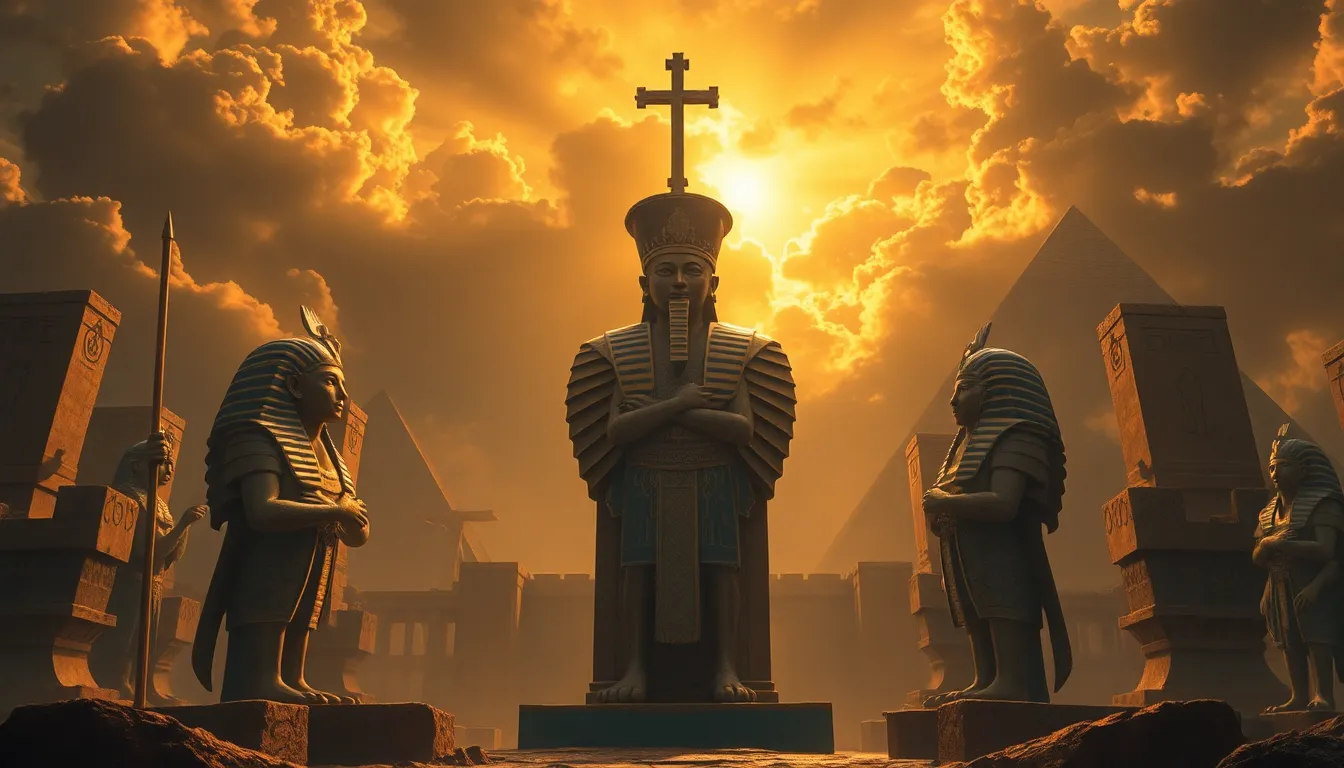The Divine Kingship: Pharaohs and Their Religious Role
I. Introduction
Divine kingship is a concept that intertwines the notions of political authority and religious sanctity, wherein the ruler is seen as a representative or embodiment of the divine on earth. In Ancient Egypt, this was epitomized by the Pharaohs, who were not only the political leaders but also held significant religious authority.
The Pharaohs of Ancient Egypt played a central role in the governance and spiritual life of the society. They were viewed as intermediaries between the gods and the people, responsible for maintaining order and harmony in both the physical and spiritual realms.
The religious role of the Pharaoh was crucial in legitimizing their power and ensuring societal stability, as the well-being of the state was believed to directly correlate with the Pharaoh’s ability to uphold divine principles.
II. Historical Context of Pharaohs
The emergence of the Pharaohs can be traced back to the early dynastic period of Ancient Egypt, around 3100 BCE, when the unification of Upper and Lower Egypt established the first Pharaoh, Narmer. This marked the beginning of a lineage that would continue for thousands of years.
Throughout Ancient Egyptian history, the Pharaohs reigned during three primary periods: the Old Kingdom (c. 2686–2181 BCE), the Middle Kingdom (c. 2055–1650 BCE), and the New Kingdom (c. 1550–1070 BCE). Each of these periods saw the evolution of the Pharaoh’s role, influenced by changing political, social, and religious dynamics.
- Old Kingdom: Known for the construction of the pyramids and the establishment of a centralized state.
- Middle Kingdom: A time of stability and cultural flourishing, with a focus on literature and art.
- New Kingdom: Marked by territorial expansion and the establishment of the Pharaohs as powerful military leaders.
Over time, the role of the Pharaoh evolved from being seen primarily as a military leader to a divine ruler with immense religious significance, culminating in the New Kingdom’s emphasis on their god-like status.
III. The Concept of Ma’at
Ma’at is a central tenet in Ancient Egyptian belief, representing truth, justice, and cosmic order. It is not merely an abstract concept but a fundamental principle that the Pharaoh was expected to embody and uphold.
The Pharaoh’s duty to maintain Ma’at was paramount, as it ensured the prosperity of the land and the favor of the gods. This relationship between Ma’at, justice, and cosmic order was crucial for the Pharaoh’s legitimacy, as any failure to uphold these principles could result in chaos and disorder.
IV. Divine Attributes of Pharaohs
Pharaohs were considered living gods, and their divine attributes were essential to their rule. This belief was reinforced through divine lineage and various divine birth myths that elevated their status above mere mortals.
Examples of specific Pharaohs and their divine claims include:
- Hatshepsut: Claimed divine birth and presented herself as a male Pharaoh, emphasizing her divine connection.
- Akhenaten: Introduced the worship of the sun god Aten, presenting himself as the sole intermediary between Aten and the people.
- Ramses II: Known as Ramses the Great, he was often depicted as a god in both art and literature.
These divine claims reinforced the Pharaoh’s authority and their role as the protector of Ma’at.
V. Religious Rituals and Ceremonies
The Pharaohs participated in various key rituals that were integral to the state’s religious life. These rituals reinforced their divine status and their connection to the gods.
- Coronation Ceremonies: Symbolizing the Pharaoh’s divine right to rule.
- Offering Rituals: Conducted to appease the gods and ensure their favor.
- Funerary Rituals: Essential for ensuring a successful transition to the afterlife.
The temples served as the centers of worship and ritual, where priests supported the Pharaoh in maintaining religious practices. Major festivals, such as the Opet Festival, celebrated the divine nature of the Pharaoh and reinforced the connection between the king and the gods.
VI. Pharaohs and the Afterlife
Beliefs surrounding death and the afterlife were deeply rooted in Ancient Egyptian culture. The Pharaoh’s journey to the afterlife was a critical aspect of their reign, as it was believed to affect the stability of the kingdom.
The Pharaoh was often buried with great pomp and elaborate funerary goods, reflecting their status. Notable burial practices included:
- Pyramids: Monumental structures that served as tombs, symbolizing the Pharaoh’s divine status and ensuring their journey to the afterlife.
- Mummification: A complex process to preserve the body for the afterlife, reflecting the belief in immortality.
- Burial Goods: Items placed in the tomb to assist the Pharaoh in the afterlife journey.
The monumental architecture of the pyramids and temples stands as a testament to the Pharaoh’s religious significance and the belief in an eternal afterlife.
VII. Art and Iconography
The representation of Pharaohs in art played a crucial role in reinforcing their divine kingship. Iconography was carefully crafted to convey their power and connection to the divine.
Symbols of divine kingship included:
- Ankh: The symbol of life, often depicted in the hands of the Pharaoh.
- Uraeus: The rearing cobra, representing sovereignty and divine authority.
- Horus Falcon: A symbol of kingship and protection.
Art and sculpture were not merely decorative but served to shape public perception of the Pharaohs as divine beings, ensuring their legacy endured through time.
VIII. Conclusion
The religious role of Pharaohs in Ancient Egypt was integral to the governance and cultural identity of the society. Their divine kingship provided a framework for understanding power, spirituality, and the cosmos.
Today, the legacy of Divine Kingship continues to fascinate scholars and enthusiasts, reflecting on how power and spirituality intersected in Ancient Egypt. The Pharaohs, as embodiments of the divine, shaped not only their own fate but also that of their people, leaving an indelible mark on history.
In conclusion, the study of Pharaohs and their religious roles offers profound insights into the complexities of ancient governance, spirituality, and the enduring human quest for meaning and order in the universe.




